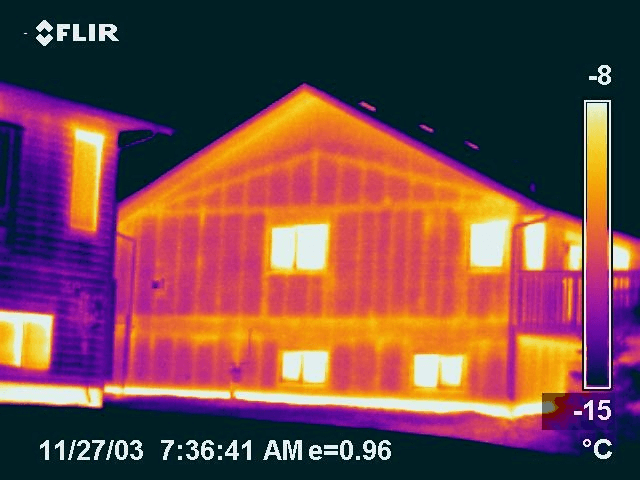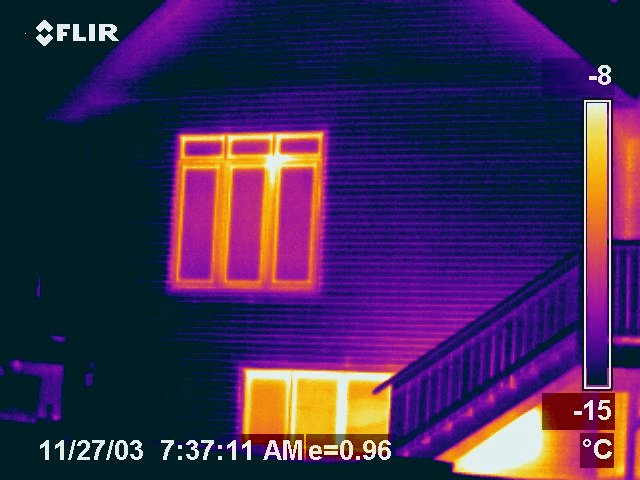The ICF Effect on Energy Efficiency
Exploring the three ways ICF walls outperform their conventional counterparts
Here’s some funny math for you. Insulated Concrete Form (ICF) walls typically save homeowners up to 50% on their energy bills. Yet, their R-values are, on average, R-23 versus R-20 in conventional stud walls. So how are these tremendous savings possible when the thermal resistance is only slightly higher?
In this post, we will discuss the “ICF effect”: a combination of continuous insulation, airtightness, and thermal lag, which together give ICF walls their stellar energy performance.
The traditional approach to insulating buildings consists of beefing up the R-value of a wall, hoping the materiality alone would reduce the flow of heat. The result? Regardless of the nominal R-values of an insulation product, every stick-built wall assembly falls victim to a common weakness – its framing members. Whether lumber or light gauge steel, the wall studs give heat an easy exit. Known as thermal bridging, this effect deals a major blow to a wall’s thermal resistance.
As science progressed, building codes began to take thermal bridging into account, and the concept of continuous insulation (c.i.) was born in jurisdictions across North America.
The empirical data behind the superiority of c.i. assemblies, such as ICFs, becomes clear in a hot box test. As a recent test showed, an ICF wall outperformed not only its wood-frame and LGS counterparts but also its nominal R-Value.
When tested, the R-23 ICF assembly (which has continuous insulation) performed at R-23.36, while the wood-framed walls (which do not have continuous insulation) consistently scored 18-26% less than their nominal R-values. Predictably, light gauge steel had the weakest performance thanks to the steel studs’ top-notch conductive properties.
As the data shows, the continuity of insulation alone can improve a wall assembly’s effective R-Value by almost 25%.


2. Airtightness
Thermal bridging is not the only means by which heat can leave a building. Convection, or heat transfer through airflow, is a common way for heat, and cold wintry air, to find their way through the envelope cracks. As building science shifts its attention from insulation to airtightness, uncontrolled air movement has become the focal point in newer codes. Quite simply, structures
that are more air tight are far more energy efficient.
Even with high-performance insulation products, wood-frame buildings do a poor job of controlling airflow. Based on a study by the RDH Building Science Laboratories, light wood frame structures dating between 2002 and 2012 have an average airflow of 4.8 Air Changes per Hour (ACH) (excluding mechanical ventilation).
In contrast, according to the same study, ICF structures see about 1.26 ACH, which is a very high level of airtightness.
That’s not to say that a stud wall can’t be made airtight. It can. But the labor hours needed to seal and tape every single crack and crevice can seriously delay a project. On the other hand, ICF walls are monolithic and don’t require extensive sealing to be airtight.
Thermal lag is the delay of heat transfer through a wall. Materials with a higher thermal mass – the ability to absorb heat – prolong this delay.
Why does thermal lag matter? Because it helps preserve the indoor air temperature even as the outdoor air cools. This lets heating systems stay inactive longer, thus giving homeowners extra savings on their energy bills.
A study done by Cleb Laboratory Inc reveals the colossal effect thermal lag has on a wall’s
energy performance. In Cleb’s guarded hot box test, a conventional low-mass stud assembly was
matched against a high-mass ICF wall.
The two walls showed vastly different results when subjected to the same plummeting temperatures in the “cold” chamber. While the stud wall chamber saw its heater come online as soon as the outdoor temperatures fell, the ICF chamber maintained its indoor temperature for more than 50 hours before the heating unit switched on.
What’s more, the ICF chamber took over 320 hours to reach its “steady-state” – a condition where the heater’s output becomes constant. During these 320 hours – or 13 days – a real-world heater would have functioned below its “steady-state” capacity, further slashing energy use.
In contrast, the stud wall reached its steady-state in only 60 hours; this delay in heat transfer gave the ICF chamber an energy savings of 149% over the stud wall!

Wrapping It Up
Days when R-values mattered most are long gone. Modern buildings demand more creative solutions to keep the outside weather where it belongs.
With ICF walls, buildings and their owners can get up to 50% in energy savings, thanks to continuous insulation, airtight walls, and delayed heat transfer. And that’s what we call the ICF effect!
For Installers
Learn more
For Homeowners
Learn more
For Architects and Designers
Learn more
For Builders & Developers
Learn more

